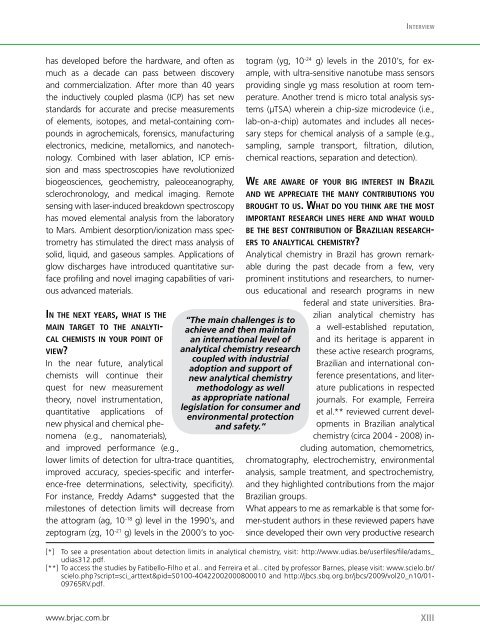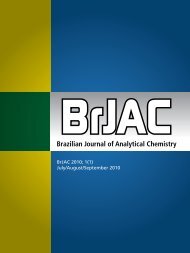Brazilian Journal of Analytical Chemistry - BRJAC - Brazilian Journal ...
Brazilian Journal of Analytical Chemistry - BRJAC - Brazilian Journal ...
Brazilian Journal of Analytical Chemistry - BRJAC - Brazilian Journal ...
You also want an ePaper? Increase the reach of your titles
YUMPU automatically turns print PDFs into web optimized ePapers that Google loves.
has developed before the hardware, and <strong>of</strong>ten as<br />
much as a decade can pass between discovery<br />
and commercialization. After more than 40 years<br />
the inductively coupled plasma (ICP) has set new<br />
standards for accurate and precise measurements<br />
<strong>of</strong> elements, isotopes, and metal-containing compounds<br />
in agrochemicals, forensics, manufacturing<br />
electronics, medicine, metallomics, and nanotechnology.<br />
Combined with laser ablation, ICP emission<br />
and mass spectroscopies have revolutionized<br />
biogeosciences, geochemistry, paleoceanography,<br />
sclerochronology, and medical imaging. Remote<br />
sensing with laser-induced breakdown spectroscopy<br />
has moved elemental analysis from the laboratory<br />
to Mars. Ambient desorption/ionization mass spectrometry<br />
has stimulated the direct mass analysis <strong>of</strong><br />
solid, liquid, and gaseous samples. Applications <strong>of</strong><br />
glow discharges have introduced quantitative surface<br />
pr<strong>of</strong>iling and novel imaging capabilities <strong>of</strong> various<br />
advanced materials.<br />
in t h E n E x t y E a r s, w h a t is t h E<br />
m a i n ta r g E t to t h E a n a ly t i-<br />
C a l C h E m i s t s in yo u r P o i n t o f<br />
v iE w?<br />
In the near future, analytical<br />
chemists will continue their<br />
quest for new measurement<br />
theory, novel instrumentation,<br />
quantitative applications <strong>of</strong><br />
new physical and chemical phenomena<br />
(e.g., nanomaterials),<br />
and improved performance (e.g.,<br />
lower limits <strong>of</strong> detection for ultra-trace quantities,<br />
improved accuracy, species-specific and interference-free<br />
determinations, selectivity, specificity).<br />
For instance, Freddy Adams* suggested that the<br />
milestones <strong>of</strong> detection limits will decrease from<br />
the attogram (ag, 10 -18 g) level in the 1990’s, and<br />
zeptogram (zg, 10 -21 g) levels in the 2000’s to yoc-<br />
www.brjac.com.br<br />
“The main challenges is to<br />
achieve and then maintain<br />
an international level <strong>of</strong><br />
analytical chemistry research<br />
coupled with industrial<br />
adoption and support <strong>of</strong><br />
new analytical chemistry<br />
methodology as well<br />
as appropriate national<br />
legislation for consumer and<br />
environmental protection<br />
and safety.”<br />
intErviEw<br />
togram (yg, 10 -24 g) levels in the 2010’s, for example,<br />
with ultra-sensitive nanotube mass sensors<br />
providing single yg mass resolution at room temperature.<br />
Another trend is micro total analysis systems<br />
(µTSA) wherein a chip-size microdevice (i.e.,<br />
lab-on-a-chip) automates and includes all necessary<br />
steps for chemical analysis <strong>of</strong> a sample (e.g.,<br />
sampling, sample transport, filtration, dilution,<br />
chemical reactions, separation and detection).<br />
wE a r E a w a r E o f yo u r Big i n t E r E s t in Br a zil<br />
a n d w E aPPrECiatE t h E m a n y Co n t r i B u t i o n s yo u<br />
B r o u g h t to u s. wh at d o yo u t h i n k a r E t h E m o s t<br />
i mP o r t a n t r EsE a rCh l i n E s h E r E a n d w h a t w o u l d<br />
BE t h E BEst Co n t r i B u t i o n o f Br a zi l i a n r EsE a rCh-<br />
Ers to a n a ly tiC a l C h E m i s t r y?<br />
<strong>Analytical</strong> chemistry in Brazil has grown remarkable<br />
during the past decade from a few, very<br />
prominent institutions and researchers, to numerous<br />
educational and research programs in new<br />
federal and state universities. Bra-<br />
zilian analytical chemistry has<br />
a well-established reputation,<br />
and its heritage is apparent in<br />
these active research programs,<br />
<strong>Brazilian</strong> and international conference<br />
presentations, and literature<br />
publications in respected<br />
journals. For example, Ferreira<br />
et al.** reviewed current developments<br />
in <strong>Brazilian</strong> analytical<br />
chemistry (circa 2004 - 2008) including<br />
automation, chemometrics,<br />
chromatography, electrochemistry, environmental<br />
analysis, sample treatment, and spectrochemistry,<br />
and they highlighted contributions from the major<br />
<strong>Brazilian</strong> groups.<br />
What appears to me as remarkable is that some former-student<br />
authors in these reviewed papers have<br />
since developed their own very productive research<br />
[*] To see a presentation about detection limits in analytical chemistry, visit: http://www.udias.be/userfiles/file/adams_<br />
udias312.pdf.<br />
[**] To access the studies by Fatibello-Filho et al.. and Ferreira et al.. cited by pr<strong>of</strong>essor Barnes, please visit: www.scielo.br/<br />
scielo.php?script=sci_arttext&pid=S0100-40422002000800010 and http://jbcs.sbq.org.br/jbcs/2009/vol20_n10/01-<br />
09765RV.pdf.<br />
XIII



